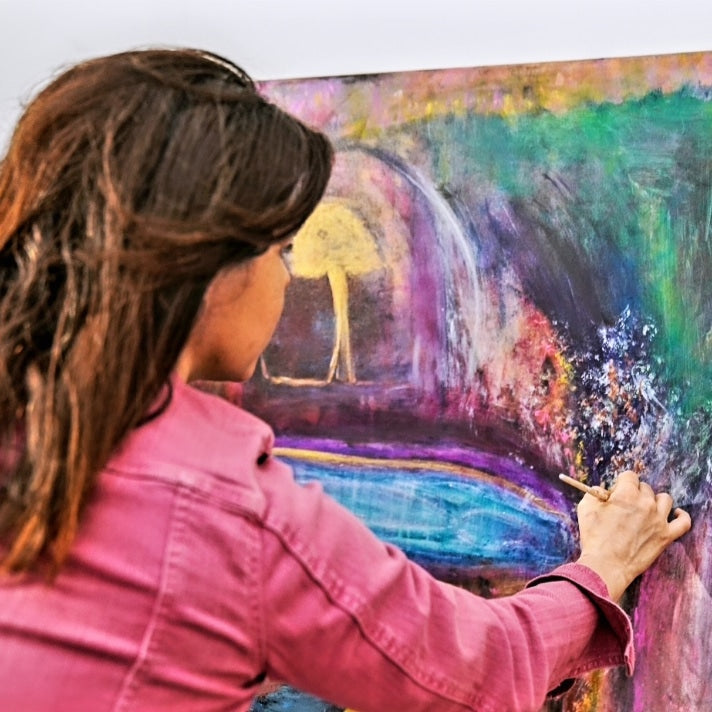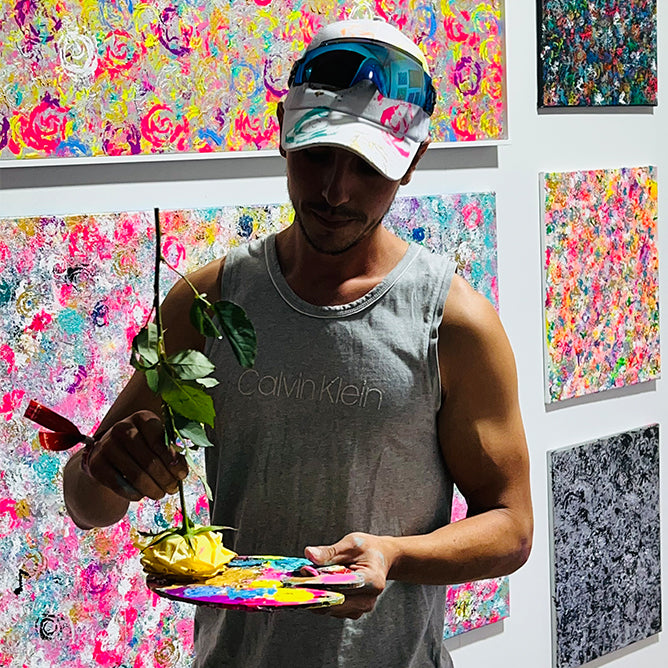Laura Basterra Sanz, born in 1979, is a multidisciplinary artist originally from Barcelona, where she earned a BA in Fashion Design from Ramon Llull University in 2005. Following this, she pursued postgraduate studies in textile printing techniques and patternmaking. Since 2018, she has been residing and working in Brussels, Belgium, focusing her practice on abstract painting and text-based art.

How did you get into art?
Creativity and expression are part of my nature. In a way, I only needed to find the medium that felt more in tune with myself. I have the drive, energy and motivation to build projects, create objects, initiate, and invent names, shapes, events, items, and concepts that speak about my life experience.
On top of that, the environment played a huge role in deciding to pursue the arts path. But, in any case, it’s my only life option, it makes me feel great, lively and energetic. Doing any other thing always gets me emotionally exhausted.
How would you describe your style? What makes your work special?
I would describe my painting approach as informalist or abstract expressionist, however, it must encompass elements that resonate more with our contemporary times rather than adhering to either of those categories.
In my text-based artworks, I could probably find traces of the DIY music and visual culture from the late 80s and first half of the 90s aesthetically speaking but, of course, they relate to my present context.
One aspect I prioritise in my painting practice is the inherent difficulty in reproducing them. I highly value and protect this sense of uniqueness. It may stem from a need to express my unique life’s vision. This extends to the uniqueness of the objects I create and the moments they represent. Each painting encapsulates a moment, impression, or sensation that can never be replicated—it reflects the constant change ingrained in life.

How do you go about developing your work?
I approach my paintings with a strong sense of freedom. The only limitations I encounter are the space where I work and the canvas itself, which provides a structure that I find favourable for the process. Once I begin painting, I do so without preconceived thoughts or plans. It's a process guided by my impulses and needs, which I find deeply satisfying. There's a dialogue between my conscious and unconscious mind. It’s a psycho-corporal practice, uncovering what lies beneath the surface, so to speak.
I seek moments where I relinquish control over what is happening. And that’s when my paintings come to life. This process is rooted in concepts of freedom, openness, expression, acceptance and instinct.
I recently read from Claudio Naranjo that it has to do with the reptilian brain, the one we use first, before all the rules, 'nos,' dangers, and all that jazz. It's like a channel to express my animality.
You must have your body unblocked, free and flexible, otherwise, you can’t do this work. This is an impossible endeavour for rigid personality types and people whose emotions are completely blocked.

Who or what influences you?
Various influences shape my work. Human connections, feelings of love or otherwise, seep into my work. Nature—its scents, sounds, and hues—inspire me deeply.
Growing up in a rather colourful city, usually bumping into works by Miró and Gaudi has shaped at least part of my visual taste. Exhibitions like recent massive Rothko's and Joan Mitchell's at the FLV resonate with my visual language, impacting me deeply and therefore my paintings.
Non-commercial music sets the tone in my studio, fostering prolonged moods and guiding series development.
I draw insight from authors, thinkers, and individuals dedicated to humanity's service, as well as like-minded peers who aid me in understanding what I do.
Recently, I came across Turkish author and lecturer Elif Shafak who illuminates Eastern-Western connections by enhancing commonalities over belief systems that separate us while at the same time, addressing controversial political, social and cultural topics in her fiction works. She speaks about sisterhood as a means to change and devaluate patriarchy, which has enriched my perspectives.
Make us curious. What are you planning to do next?
I plan to continue painting, experimenting, playing, and creating as much as life allows. Additionally, I aim to further develop my project, shaping it to my new needs and applying new ideas. Currently, I have an opportunity related to merchandising for museums in the USA, and I hope to secure many interesting exhibition opportunities soon.
Furthermore, I am beginning to actively participate in shaping new narratives for the visual arts community in the Flemish and Brussels territories of Belgium. This initiative is in collaboration with the Flanders Arts Institute - Kunstenpunt - and NICC - an association dedicated to advocating for and supporting visual artists. Together with other visual artists and arts professionals, we have been working on topics related to health and well-being.

Learn more about the artist:




